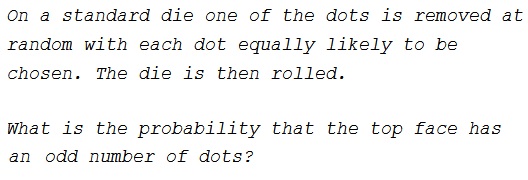Rolling Defective Die
Problem

Solution
Originally, there are $1+2+3+4+5+6=21$ dots of which $1+3+5=9$ are on the odd numbered faces and $2+4+6$ are one the even numbered faces. After a dot was removed, there are either two even faces and four odd faces or four even faces and two odd faces. The probability of the first event is $\displaystyle \frac{12}{21};$ the probability of the second one is $\displaystyle \frac{9}{21}.$ In the first case the probability of having an odd face on top is $\displaystyle \frac{4}{6};$ it is $\displaystyle \frac{2}{6}$ for the second case. Since all the variants are mutually exclusive, the total probability is
$\displaystyle\frac{4}{6}\cdot\frac{12}{21}+\frac{2}{6}\cdot\frac{9}{21}=\frac{2\cdot 12+9}{3\cdot 21}=\frac{11}{21}.$
Acknowledgment
This is problem 14 from the 2005 AMC 12A. That's a borrowing from J. D. Faires' First Steps for Math Olympians, MAA, 2006.
|Contact| |Front page| |Contents| |Probability|
Copyright © 1996-2018 Alexander Bogomolny73570665
